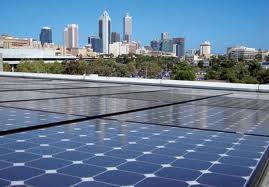Australia is world renowned as being the land of sunshine, kangaroos, and koalas. I like to remind my international solar colleagues that we also have spiders, snakes, sharks, and politicians (in increasing order of danger). Australia’s solar industry has had more than our fair share of premature changes to incentives and policies. So on my first visit to the world’s largest solar trade show, it was eye-opening to discover that (contrary to my expectation) the Australian solar power sector has a lot going for it.
I spent one and a half days engaging with industry analysts from around the globe. First at SolarPlaza’sDemand Conference, then at the IEA-PVPS meeting of national solar organisations, where I was representing the APVA. The other two-and-a-half days was spent wandering through a solar exhibition space bigger than the entire Melbourne Convention Centre. Here’s a reminder of why Australia is the best country for solar power, followed by a summary of technology trends at Intersolar.
Unlike many countries whose incentives targeted solar farms, our incentives targeted voters. This created a formidable voting block that has prevented retrospective changes to feed-in tariffs, as the NSW and Queensland governments have discovered. Many European countries have suffered far worse fates. Indeed, unlike the Czech republic, we have a right to self-consume the power we generate (something the Queensland Competition Authority tried to scrap but backed down in the face of overwhelming opposition).
Still, everyone is horrified that our net metering occurs on a half-hourly basis; in most countries ‘net metering’ occurs on an annual basis. And while we receive little value for the excess power, thanks to the greed of network operators (mostly owned by state governments), a solar power system can offset some of the highest priced electricity in the world with some of the world’s best solar resource. This means that despite the lack of PV-specific subsidies, Australian solar power has great economics, economics that are thankfully no longer dependent upon PV-focussed incentives.
Still, our political influence pales in comparison to that of the German solar power industry. I was shocked to find they only self-consume 20% of the power generated from a 5kW system (in Australia the figure is about 50%). This leads to high dependency upon the government-set value given for exported power.
But rather than settle for a smaller system that would increase self-consumption levels, the German solar industry organisation is able to powerfully tell the German government that if it wants to achieve its energy transition (away from polluting sources), they must provide sufficient incentive for solar.
Meanwhile, the German government has created an incentive that will keep everybody happy, including the networks. There is an upfront subsidy for grid-interactive battery systems that act to increase self consumption – the same solution that could provide a superior-value alternative to network augmentation in Australia. Like Queensland, Germany is also considering how to ensure that solar owners pay a fair share of network costs, though hasn’t yet identified a sensible answer.
Latest trend: battery storage and battery-backup grid-interactive inverters. The German government has created a subsidy for battery-backup grid-interactive systems, which means there’s a plethora of batteries and inverters at intersolar this year, all drawing a crowd. I was happy to see Selectronic’s Australian-made technology creating some interest, and to see the Kaco-branded Selectronic-Kaco joint developed product attracting attention on Kaco’s stand. Despite there being only sufficient funding for 5000-7000 systems in Germany, Australia is likely to be a beneficiary of the technology development that occurs in this space.
Hot Topic: Anti-dumping tariffs – its likely that the price of solar panels in Europe will rise due to the introduction of punitive tariffs on Chinese panels. Most of the people I spoke with weren’t happy with this situation. Of course, there is likely to be flow-on effects of price and providers into Australia.
Biggest Difference to Australia (apart from beer on tap at many stands): The data logging provider SolarLog was always busy. Logging system performance is essential in Europe, where investors want to track their return.
Coolest technology: Solar drones – infrared cameras mounted on high-power drones for finding hot spots in faulty solar panels, an essential technology to quickly cover the thousands of panels in a solar farm. (This narrowly beat an electric wheelbarrow wheeled about by a Bavarian woman in high heels; panel-cleaning robots came a distant third).
Watch this space: Refusol’s PV hot water heating system – its retrofit-able, and direct DC so eliminates roof plumbing, but unfortunately it won’t soak up your excess AC production. Also, there’s some whitegood manufacturers bringing out smarthome/solar friendly equipment that will be able to increase self-consumption of generated solar power, thereby improving economics.
Market Synopsis
PV Market
- 85 MW of PV was registered in May, a substantial upswing on the prior months’ figures.
- Queensland was the hot market in May (and again in June), responsible for the entire upswing and returning to 40% of the Australian PV market in May
- Though many are feeling the pain, some are doing well enough to compensate for others’ losses. Similar volumes have been registered this year as at the same point last year – true nationally and in each state. However, this is because there are far fewer sales but the average system size has increased to compensate; nevertheless business profitability is difficult due to declining system prices.
- With the highest PV density of any postcode in the Nation, 4109 (Robertson, QLD) wastes least of its incoming solar resource. 575 kW of PV per square-kilometre – equivalent to 0.575 W/m2 of PV coverage.
Warwick Johnston is head of SunWiz.










